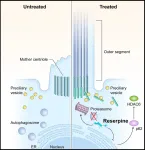(Press-News.org) Life comes in all shapes in sizes, but some sizes are more popular than others, new research from the University of British Columbia has found.
In the first study of its kind published today in PLOS ONE, Dr. Eden Tekwa, who conducted the study as a postdoctoral fellow at UBC’s department of zoology, surveyed the body sizes of all Earth’s living organisms, and uncovered an unexpected pattern. Contrary to what current theories can explain, our planet’s biomass—the material that makes up all living organisms—is concentrated in organisms at either end of the size spectrum.
“The smallest and largest organisms significantly outweigh all other organisms,” said Dr. Tekwa, lead author of “The size of life,” and now a research associate with McGill University’s department of biology. “This seems like a new and emerging pattern that needs to be explained, and we don’t have theories for how to explain it right now. Current theories predict that biomass would be spread evenly across all body sizes.”
In addition to challenging our understanding of how life is distributed, these results have important implications for predicting the effects and impacts of climate change. “Body size governs a lot of global processes as well as local processes, including the rate at which carbon gets sequestered, and how the function and stability of ecosystems might be affected by the composition of living things,” said Dr. Tekwa. “We need to think about how body size biomass distribution will change under environmental pressures.”
"Life constantly amazes us, including the incredible range of sizes that it comes in,” says senior author Dr. Malin Pinsky, associate professor in the department of ecology, evolution, and natural resources at Rutgers University. “If the tiniest microbe was the size of the period at the end of this sentence, the largest living organism, a sequoia tree, would be the size of the Panama Canal."
To obtain their results, Dr. Tekwa spent five years compiling and analyzing data about the size and biomass of every type of living organism on the planet—from tiny one-celled organisms like soil archaea and bacteria to large organisms like blue whales and sequoia trees. They found that the pattern favouring large and small organisms held across all types of species, and was more pronounced in land-based organisms than in marine environments. Interestingly, maximum body size seemed to reach the same upper limits across multiple species and environments.
“The largest body sizes appear across multiple species groups, and their maximum body sizes are all within a relatively narrow range,” Dr. Tekwa noted. “Trees, grasses, underground fungi, mangroves, corals, fish and marine mammals all have similar maximum body sizes. This might suggest that there is a universal upper size limit due to ecological, evolutionary or biophysical limitations.”
Dr. Tekwa was also able to uncover some intriguing details about the distribution of life in various ecosystems. “Even though corals occur in only a small fraction of the ocean, it turns out that they have about the same biomass as all the fish in the ocean,” said Dr. Tekwa. “This illustrates how important the balance of biomass is in the oceans. Corals support a lot of fish diversity, so it's really interesting that those two organisms have almost the same biomass.”
As for humans, we already know we comprise a relatively small biomass, but our size among all living things reveals our place in the global biome. “We belong to the size range that comprises the highest biomass, which is a relatively large body size,” said Dr. Tekwa.
Dr. Tekwa added that their findings will help inform future research into Earth’s evolving environment. “This enables us to move forward, because it establishes a baseline of the current state that already includes human-driven effects,” they said. “For example, fish biomass is probably half of what it was before humans arrived, but it gets harder and harder to infer those patterns as we go farther back in geological time. These are really important empirical studies to conduct. There's a lot of relevance to humans and societies as we tackle sustainability challenges, and global ecological assessments should be an essential part of sustainability initiatives.”
END
Earth prefers to serve life in XXS and XXL sizes: UBC research
2023-03-29
ELSE PRESS RELEASES FROM THIS DATE:
Nature favors all creatures great and small over medium size
2023-03-29
Life may come in all shapes and sizes, but in nature the most extreme size ranges predominate, according to Rutgers researchers.
A survey of body sizes of Earth organisms, published Wednesday, March 29, in the science journal PLoS ONE, shows that the planet’s biomass – the material that makes up all living organisms – is concentrated in organisms at either end of the size spectrum.
“This conclusion – that life on earth comes packaged predominantly in the largest and smallest sizes – was a discovery that surprised us,” said Malin Pinsky, an associate professor ...
Sox9 protein enables molecular time travel that can lead to colorectal cancer
2023-03-29
Study Title: Aberrant cell state plasticity mediated by developmental reprogramming precedes colorectal cancer initiation
Publication: Science Advances: March 29, 2023, 2:00pm ET 10.1126/sciadv.adf0927
Dana-Farber Cancer Institute author: Pratyusha Bala, PhD, Jonathan P. Rennhack, PhD, Daulet Aitymbayev, MS, Matthew B. Yurgelun, MD, William C. Hahn, MD, PhD, Nilay S. Sethi, MD, PhD
Summary:
Normally the lining of the colon forms a series of steep hills and valleys. At the surface, where the hills peak, are functional colon cells that do the organ’s work of absorption and secretion. Deep in the valleys are stem cells that constantly ...
Ancient African empires’ impact on migration revealed by genetics
2023-03-29
Traces of ancient empires that stretched across Africa remain in the DNA of people living on the continent, reveals a new genetics study led by UCL researchers.
Published in Science Advances, the collaboration between UCL geneticists working alongside anthropologists, archaeologists, historians and linguists in Africa and beyond found evidence for when different peoples intermixed across the continent. Their findings indicate migration linked to vast empires such as the Kanem-Bornu and the kingdoms of Aksum and Makuria, ...
Method for improving seasonal flu vaccines also aids pandemic prediction
2023-03-29
(MEMPHIS, Tenn. – March 29, 2023) Improving the seasonal influenza vaccine and public health specialists’ ability to predict pandemic potential in new flu strains may be possible due to new findings from scientists at St. Jude Children’s Research Hospital. The key is the stability of a viral protein that gains entry into human cells. The findings were published today in Science Advances.
“We found that the protein flu viruses use to enter cells, hemagglutinin, needs to be relatively stable and resistant to acid in an effective H3N2 flu vaccine,” said senior and co-corresponding ...
Model for predicting transmission of COVID-19 can help policymakers monitor virus, inform health surveillance systems
2023-03-29
The COVID-19 pandemic presents unprecedented challenges to public health worldwide. Tracking the dynamics of the coronavirus permits governments, organizations, and individuals to make projections in an effort to curb the spread of the pandemic. But while a large amount of data about COVID is collected and publicly available, the information can be unreliable and subject to bias. In a new study, researchers analyzed data from Cali, Colombia, to develop a model that provides a template for tracking data, predicting transmission, and informing health surveillance systems.
The study was conducted by researchers at Carnegie Mellon ...
FDA-approved drug shows promise in lab models for blinding childhood disease
2023-03-29
A National Eye Institute-led team has identified a compound already approved by the U.S. Food and Drug Administration that keeps light-sensitive photoreceptors alive in three models of Leber congenital amaurosis type 10 (LCA 10), an inherited retinal ciliopathy disease that often results in severe visual impairment or blindness in early childhood.
LCA 10 is caused by mutations of the cilia-centrosomal gene (CEP290). Such mutations account for 20% to 25% of all LCA – more than any other gene.
Using a mouse model of LCA10 and two types of lab-created tissues from stem ...
OHIO diabetes researchers discover the potential of CIDEC protein to mitigate obesity-related cardiometabolic disease
2023-03-29
A team of researchers from Ohio University’s Heritage College of Osteopathic Medicine recently discovered a novel role of human-CIDEC gene in improving metabolic dysfunction and cardiovascular health. The study, “Endothelial-Specific Expression of CIDEC Improves High-Fat Diet–Induced Vascular and Metabolic Dysfunction,” published in Diabetes focuses on vascular function and its association with metabolic diseases like insulin resistance, Type 2 diabetes, and cardiovascular disease.
“This is a very impactful study, and we have moved in the right direction to find a way to reduce cardiovascular ...
The COVID-19 pandemic has increased – but also polarised – trust in science
2023-03-29
Research by the Milner Centre for Evolution at the University of Bath, UK, along with colleagues at Universities of Oxford and Aberdeen, finds that trust in scientists has hugely increased overall since the COVID-19 pandemic, but that attitudes have also become more polarized. The study also found that people were more likely to take the COVID-19 vaccine if their trust in the science had increased.
Whether it be climate change, vaccines or GM foods, trust in science and scientists has rarely been more important. ...
DoD funds new project aimed at protecting global supply chains, infrastructure
2023-03-29
Thanks to the work of Arizona Sen. Mark Kelly, a new project led by Northern Arizona University, with various collaborators throughout the nation, will help the United States better protect the critical supply chain infrastructure and the supply chains that keeps the country and its economy running.
Benjamin Ruddell, professor in the School of Informatics, Computing, and Cyber Systems and founder of the FEWSION project, is the NAU lead. Funded at $8 million for year one, the project aims to work with technology known as Fused Global Data Analytics and Visualization. The team’s leadership, ...
CNIO researchers help to understand the functioning of the protein that makes DNA loops in the human genome
2023-03-29
Cohesin is a ring-shaped protein that surrounds and moves around the DNA molecule, forming the loops. It is a crucial process for the cell.
Understanding how cohesin works has been one of the challenges of molecular biology in recent decades.
The work now published by Ana Losada's group at CNIO will serve to deepen our understanding of the disease known as Cornelia de Lange syndrome.
At the end of the 1990s, Ana Losada, a researcher at the Spanish National Cancer Research Centre (CNIO), then at the Cold Spring Harbor Laboratory (New York, USA), discovered a protein in frogs of the Xenopus genus that is fundamental to ...


